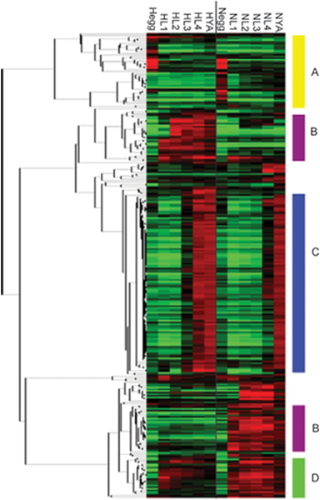User:Z3332863: Difference between revisions
(→Lab 2) |
(→Lab 2) |
||
| Line 35: | Line 35: | ||
==== Lab 2 ==== | ==== Lab 2 ==== | ||
''' | '''Genes that Display Strain Variation in C. elegans''' | ||
[[File:Genes that display strain variation.png]] | [[File:Genes that display strain variation.png]] | ||
'''Description''' | |||
Capra et al were studying the variation in gene expression during the different stages of Development of different isolates of C. elegans. This image is a microarray result, showing genes that are expressed in different amounts in different strains of C. elegans during development. This Micrarray shows allow these differentially expressed genes to be classified into 4 groups. It’s likely the genes in the same cluster are regulated in the same way. | |||
'''Reference''' | '''Reference''' | ||
| Line 45: | Line 49: | ||
2008 Capra et al. This is an open-access article distributed under the terms of the Creative Commons Attribution License, which permits unrestricted use, distribution, and reproduction in any medium, provided the original author and source are credited. | 2008 Capra et al. This is an open-access article distributed under the terms of the Creative Commons Attribution License, which permits unrestricted use, distribution, and reproduction in any medium, provided the original author and source are credited. | ||
{{Template:Student Image}} | |||
---- | ---- | ||
Revision as of 15:03, 5 August 2012
Lab Attendance
Lab 1 --Z3332863 11:47, 25 July 2012 (EST)
Lab 2 --Z3332863 10:20, 1 August 2012 (EST)
Individual Assessments
Lab1
Origin of Nobel Prize & Discoverer
In 2010, Robert G. Edwards won the Nobel Prize for developing In vitro Fertilisation. IVF originated in 1950s when Edwards began fertilizing human eggs in cell culture dishes as a way of treating infertility. In 1978, Edward's IVF technology gave the world's first IVF baby. Over the next few years, Edwards and his team fine-tuned the technique of IVF.
Research paper on fertilisation:
<pubmed>22317970</pubmed>
What does this paper tell us about fertilisation?
This article looks at the rise of aneuploidies in IVF embryos from women around 40yrs of age. To do this Handyside et al, used 'microarray comparative genomic hybridisation' technology to study the chromosome copy number in the zygote, the 1st and 2nd polar bodies in older women receiving IVF treatment. Handyside et al found that:
- Most of the aneuploidies of IVF embryos arose from the 2nd meiotic division of the oocyte. This is surprising because most aneuploidies in naturally fertilized embryos arise from Meiosis I of the oocyte.
- Aneuploidies in IVF zygotes were not due to non-disjunction of chromosomes in the oocyte. Instead, these Aneuploidies were due to predivision of the chromatids in the oocyte.
- In IVF zygotes made from aged oocytes, often there were multiple aneuploidies in 1 zygote.
By looking at the origin of aneuploidies in IVF zygotes, these scientists are trying to find a way to reduce these aneuploidies.
Lab 2
Genes that Display Strain Variation in C. elegans
Description
Capra et al were studying the variation in gene expression during the different stages of Development of different isolates of C. elegans. This image is a microarray result, showing genes that are expressed in different amounts in different strains of C. elegans during development. This Micrarray shows allow these differentially expressed genes to be classified into 4 groups. It’s likely the genes in the same cluster are regulated in the same way.
Reference <pubmed>19116648</pubmed>
Copyright 2008 Capra et al. This is an open-access article distributed under the terms of the Creative Commons Attribution License, which permits unrestricted use, distribution, and reproduction in any medium, provided the original author and source are credited.
- Note - This image was originally uploaded as part of an undergraduate science student project and may contain inaccuracies in either description or acknowledgements. Students have been advised in writing concerning the reuse of content and may accidentally have misunderstood the original terms of use. If image reuse on this non-commercial educational site infringes your existing copyright, please contact the site editor for immediate removal.
